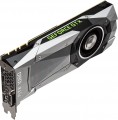GPU clock speed
The frequency of the graphics processor of the graphics card. As a general rule, the higher the frequency of the GPU, the higher the performance of the graphics card, but this parameter is not the only one — a lot also depends on the design features of the graphics card, in particular, the type and amount of video memory (see the relevant glossary items). As a result, it is not unusual for a model with a lower processor frequency to be more performant of two video cards. In addition, it should be noted that high-frequency processors also have high heat dissipation, which requires the use of powerful cooling systems.
DVI-D
The number of DVI-D outputs provided by the graphics card.
The
DVI-D interface provides digital video signal transmission. Depending on the version, the maximum resolution of such a video can be 1920x1200 (Single Link) or 2560x1600 (Dual Link); the specific version used generally depends on the general purpose and price point of the graphics card. However, anyway, this interface is very popular in modern monitors, but it is almost never found in other screens.
The presence of several outputs allows you to connect several screens to the graphics card at the same time — for example, a pair of monitors for organizing an extended workspace. Specifically, up to 4 DVI-D outputs can be provided.
DVI-I
The number of DVI-I outputs provided by the graphics card.
DVI-I is a hybrid standard that allows both digital and analogue video to be transmitted. The "digital part" of such an interface is similar to DVI-D, it can be performed in the Single Link or Dual Link version and support resolutions up to 1920x1200 or 2560x1600, respectively. The “analogue part” corresponds to VGA in terms of capabilities: it supports resolutions up to 1280x1024, and the VGA screen can be connected to the DVI-I output via a simple adapter.
The presence of several outputs allows you to connect several screens to the graphics card at the same time — for example, a pair of monitors for organizing an extended workspace. Modern graphics cards can have up to 3 DVI-I connectors.
Lighting
The graphics card has a
backlight system. This feature gives the board an original appearance, which is especially appreciated by gamers and fans of external PC modding. The backlight may have a different colour, in some models this colour may even change. At the same time, note that this feature does not affect the functionality of the graphics card, but it significantly affects the cost. So it's worth specifically looking for a graphics card with backlighting only in cases where an unusual design is no less important to you than performance. It should also be borne in mind that such adapters must be installed in the appropriate cases — open or with a viewing window, otherwise the backlight will simply not be visible.
Power consumption
Maximum power consumed by the graphics card during operation. This parameter is important for calculating the total power consumed by the entire system and selecting a power supply that provides the appropriate power.
Minimum PSU recommendation
The smallest power supply recommended for a computer with this graphics card.
This parameter, usually, is much higher than the power consumption of the graphics card itself. This is natural — after all, the PSU must provide electricity to the entire system, not just the video adapter. At the same time, the higher the power of the graphics card, the inevitably higher the power consumption of the PC as a whole. Moreover, this is due not only to the “voracity” of the graphics adapter itself, but also to the consumption of other PC components: a high-end graphics card, usually, is combined with an equally powerful (and energy-intensive) system.
With this in mind, manufacturers indicate the minimum recommended power supply. Of course, such recommendations are not mandatory; however, when using a PSU with a power lower than the recommended one, the probability of malfunctions increases significantly — to the point that even a very limited system may simply “not start”.
Length
The total length of the graphics card.
In this case, the length means the size of the device from the plate with connectors (which is attached to the back wall of the system unit) to the opposite side. The plate itself and the outwardly protruding connectors are usually not taken into account.
Data on the length of the graphics card is needed primarily in order to assess whether there is enough space for it in a particular case. In addition, longer boards, usually, have more advanced characteristics (although there is no hard dependence here, and video adapters of similar class may have different lengths). As for specific values, the most compact solutions nowadays have a size of
150 – 200 mm or
less ; an indicator of
200 – 250 mm can still be considered relatively small,
250 – 290 mm — medium, and many models (mostly advanced) have a length
of more than 290 mm.

